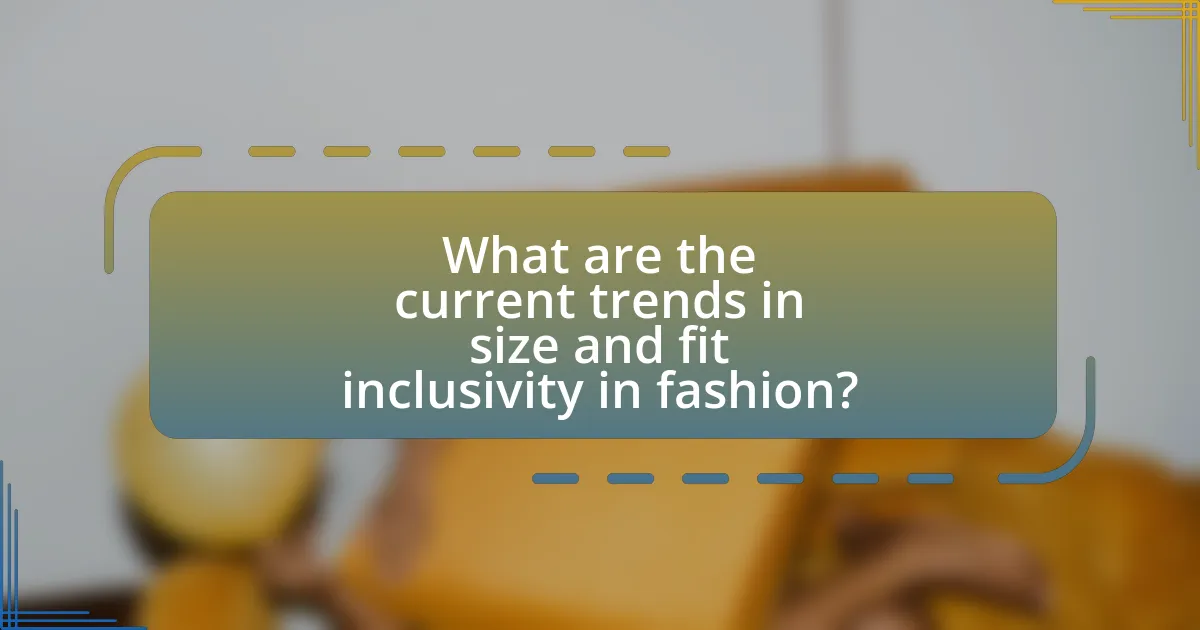The article focuses on the evolving trends in size and fit inclusivity within the fashion industry, highlighting the increasing demand for diverse sizing options and representation. It discusses how brands are expanding their size ranges, utilizing technology like 3D body scanning and virtual fitting rooms, and responding to consumer demands for inclusivity. Key factors driving this shift include social movements advocating for body positivity, the influence of digital platforms, and the economic benefits of adopting inclusive sizing practices. The article also examines the challenges brands face in achieving inclusivity and outlines best practices for ensuring ongoing commitment to diverse body representation in fashion.

What are the current trends in size and fit inclusivity in fashion?
Current trends in size and fit inclusivity in fashion emphasize a broader range of sizes and body types, reflecting a shift towards diversity and representation. Brands are increasingly offering extended size ranges, with many now providing options up to size 30 or beyond, catering to a wider demographic. Additionally, the use of technology, such as 3D body scanning and virtual fitting rooms, allows for personalized fit solutions, enhancing the shopping experience for consumers of all sizes. According to a 2022 report by McKinsey & Company, 67% of consumers expressed a desire for brands to offer more inclusive sizing, highlighting the demand for these changes in the industry.
How is the fashion industry redefining size inclusivity?
The fashion industry is redefining size inclusivity by expanding size ranges and promoting diverse body representations in marketing and runway shows. Brands like Savage X Fenty and Aerie have set industry standards by offering sizes that cater to a broader spectrum of body types, with Savage X Fenty showcasing models of various sizes during its fashion shows. Additionally, data from a 2021 study by the NPD Group indicates that 67% of women in the U.S. feel that the fashion industry does not cater to their body type, prompting brands to rethink their sizing strategies and adopt more inclusive practices. This shift not only addresses consumer demand but also reflects a growing recognition of body positivity and diversity in fashion.
What are the key factors driving the shift towards inclusivity?
The key factors driving the shift towards inclusivity in fashion include consumer demand for diversity, social movements advocating for representation, and the influence of digital platforms. Consumer demand for diversity has increased as individuals seek brands that reflect their identities and experiences, leading to a broader range of sizes and styles being offered. Social movements, such as body positivity and gender equality, have raised awareness about the importance of representation in fashion, prompting brands to adopt more inclusive practices. Additionally, digital platforms enable marginalized voices to be heard, creating pressure on brands to respond to calls for inclusivity. These factors collectively contribute to a transformative shift in the fashion industry towards greater inclusivity.
How do consumer demands influence size and fit trends?
Consumer demands significantly influence size and fit trends by driving brands to adopt more inclusive sizing practices. As consumers increasingly prioritize body positivity and representation, fashion companies respond by expanding their size ranges and offering diverse fits to cater to a broader audience. For instance, a 2021 survey by the NPD Group found that 67% of consumers believe that brands should offer more sizes, leading many retailers to implement size inclusivity strategies. This shift not only reflects consumer preferences but also impacts sales, as brands that embrace diverse sizing often see increased customer loyalty and market share.
What role does technology play in enhancing fit inclusivity?
Technology plays a crucial role in enhancing fit inclusivity by enabling personalized sizing solutions and improving garment fitting processes. Innovations such as 3D body scanning and virtual fitting rooms allow consumers to receive accurate size recommendations based on their unique body measurements, significantly reducing the likelihood of returns due to poor fit. For instance, companies like Fit3D and Zeekit utilize advanced algorithms and data analytics to create tailored shopping experiences that cater to diverse body shapes and sizes. This technological integration not only fosters a more inclusive shopping environment but also promotes body positivity by acknowledging and accommodating a wider range of body types in fashion.
How are 3D body scanning and virtual fitting rooms changing the landscape?
3D body scanning and virtual fitting rooms are revolutionizing the fashion industry by enhancing size and fit inclusivity. These technologies allow consumers to obtain precise body measurements, which leads to better-fitting garments and reduces the likelihood of returns due to sizing issues. According to a study by the National Institute of Standards and Technology, accurate body scanning can improve fit by up to 30%, significantly impacting customer satisfaction and brand loyalty. Furthermore, virtual fitting rooms enable customers to visualize how clothing will look on their unique body shapes, fostering a more personalized shopping experience and encouraging diverse body representation in fashion.
What innovations are brands adopting to improve size offerings?
Brands are adopting innovations such as 3D body scanning technology and customizable sizing options to improve size offerings. 3D body scanning allows brands to capture precise body measurements, enabling them to create garments that fit a wider range of body types. For instance, companies like Unspun utilize this technology to produce custom-fit jeans based on individual measurements, significantly enhancing fit inclusivity. Additionally, brands are implementing AI-driven algorithms to analyze customer data and predict size preferences, which helps in developing more accurate size ranges. This approach is exemplified by companies like ASOS, which uses machine learning to recommend sizes based on previous purchases and returns, thereby reducing size-related issues.
Why is size and fit inclusivity important for brand success?
Size and fit inclusivity is crucial for brand success because it directly impacts customer satisfaction and loyalty. Brands that offer a diverse range of sizes and fits can cater to a broader audience, thereby increasing their market reach. According to a study by the Council of Fashion Designers of America, 67% of women in the U.S. wear sizes 14 and above, yet many brands fail to provide options for this demographic, resulting in lost sales opportunities. Additionally, inclusive sizing fosters a positive brand image, as consumers increasingly prioritize brands that reflect diversity and body positivity. This alignment with consumer values can lead to enhanced brand loyalty and advocacy, ultimately driving sales and growth.
How does inclusivity impact customer loyalty and brand perception?
Inclusivity significantly enhances customer loyalty and positively influences brand perception. Brands that embrace inclusivity demonstrate a commitment to diversity, which resonates with consumers, fostering emotional connections and trust. According to a study by McKinsey & Company, companies in the top quartile for gender diversity on executive teams are 21% more likely to experience above-average profitability, indicating that inclusivity can drive financial performance and customer loyalty. Furthermore, research from the Harvard Business Review shows that 70% of consumers are more likely to purchase from brands that reflect their values, including inclusivity. This alignment between brand values and consumer expectations strengthens brand loyalty and enhances overall perception in the marketplace.
What are the economic benefits of adopting inclusive sizing?
Adopting inclusive sizing generates significant economic benefits by expanding market reach and increasing sales. Brands that offer a wider range of sizes can tap into the approximately 67% of women in the U.S. who wear sizes 14 and above, a demographic often underserved in the fashion industry. This inclusivity not only attracts new customers but also fosters brand loyalty, as consumers are more likely to support brands that cater to diverse body types. Furthermore, research from the Council of Fashion Designers of America indicates that inclusive sizing can lead to a 30% increase in sales for brands that implement it effectively. By addressing the needs of a broader audience, companies can enhance their profitability and market competitiveness.

How are brands responding to the demand for inclusivity?
Brands are responding to the demand for inclusivity by expanding their size ranges, incorporating diverse models in marketing campaigns, and actively engaging with underrepresented communities. For instance, major fashion retailers like ASOS and Nike have introduced extended size options to cater to a broader audience, reflecting a commitment to inclusivity. Additionally, a report by McKinsey & Company highlights that brands that prioritize diversity in their advertising see a 20% increase in customer engagement, demonstrating the positive impact of inclusive practices on brand perception and sales.
What strategies are successful brands implementing for size inclusivity?
Successful brands are implementing strategies such as expanding size ranges, utilizing diverse models in marketing, and incorporating customer feedback into product development for size inclusivity. For instance, brands like Aerie and Savage X Fenty have introduced extended size offerings, catering to a broader audience and promoting body positivity. Additionally, these brands often feature models of various sizes in their campaigns, which not only reflects their commitment to inclusivity but also resonates with consumers seeking representation. Furthermore, companies are increasingly engaging with customers through surveys and social media to understand their needs and preferences, ensuring that product lines are more aligned with the diverse body types of their customer base.
How do collaborations with diverse influencers enhance brand reach?
Collaborations with diverse influencers enhance brand reach by tapping into varied audience segments and fostering authentic connections. Diverse influencers represent different demographics, which allows brands to engage with a broader consumer base, increasing visibility and relatability. For instance, a study by the Influencer Marketing Hub found that campaigns featuring diverse influencers can achieve up to 50% higher engagement rates compared to those with a homogenous influencer pool. This increased engagement translates to greater brand awareness and loyalty, as consumers are more likely to trust and relate to influencers who reflect their own experiences and identities.
What marketing approaches are effective in promoting inclusivity?
Effective marketing approaches for promoting inclusivity include diverse representation in advertising, community engagement, and personalized messaging. Diverse representation ensures that marketing materials feature individuals of various sizes, ethnicities, and backgrounds, which resonates with a broader audience and fosters a sense of belonging. Community engagement involves collaborating with diverse groups to understand their needs and preferences, leading to more relevant products and campaigns. Personalized messaging tailors communication to reflect the values and experiences of different demographics, enhancing relatability and connection. Research indicates that brands prioritizing inclusivity in their marketing strategies see increased customer loyalty and brand perception, as evidenced by a 2021 study by McKinsey & Company, which found that companies with diverse leadership teams are 25% more likely to outperform their peers in profitability.
What challenges do brands face in achieving size inclusivity?
Brands face significant challenges in achieving size inclusivity, primarily due to limited production capabilities and market demand perceptions. Many brands struggle to expand their size ranges because producing a wider variety of sizes can increase costs and complicate inventory management. Additionally, there is often a misconception that larger sizes do not sell as well, leading brands to prioritize smaller sizes that they believe will yield higher profits. According to a 2021 study by the NPD Group, 67% of women in the U.S. wear a size 14 or larger, indicating a substantial market that brands may overlook. This disconnect between consumer demand and brand offerings highlights the challenges in aligning production strategies with actual market needs.
How do production costs affect the implementation of inclusive sizing?
Production costs significantly influence the implementation of inclusive sizing by determining the feasibility of producing a wider range of sizes. Higher production costs arise from the need for additional materials, labor, and specialized manufacturing processes required to create diverse sizes, which can deter brands from adopting inclusive sizing practices. For instance, a study by the Council of Fashion Designers of America indicates that brands may face a 20-30% increase in costs when expanding size ranges, leading many to prioritize standard sizes that yield higher profit margins. Consequently, the financial implications of production costs can limit the commitment of fashion companies to inclusivity in sizing.
What barriers exist in changing consumer perceptions of size?
Barriers in changing consumer perceptions of size include entrenched societal norms, marketing practices, and psychological factors. Societal norms often dictate ideal body sizes, leading to stigma against larger bodies, which can perpetuate negative perceptions. Marketing practices frequently emphasize narrow beauty standards, reinforcing the idea that only certain sizes are desirable. Psychological factors, such as internalized body image issues and cognitive biases, can further complicate acceptance of diverse sizes. Research indicates that these barriers are deeply rooted, making it challenging to shift consumer attitudes toward size inclusivity in fashion.

What are the future predictions for size and fit inclusivity in fashion?
Future predictions for size and fit inclusivity in fashion indicate a significant shift towards broader representation and customization. Industry experts forecast that brands will increasingly adopt technology, such as 3D body scanning and AI-driven fit algorithms, to create personalized clothing that accommodates diverse body shapes and sizes. According to a report by McKinsey & Company, the global apparel market is projected to grow by 4% to 5% annually, with inclusivity being a key driver of this growth as consumers demand more options that reflect their individual needs. Additionally, the rise of social media and body positivity movements is pushing brands to expand their size ranges and promote diverse models, leading to a more inclusive fashion landscape.
How will consumer expectations evolve in the coming years?
Consumer expectations in the fashion industry will increasingly prioritize size and fit inclusivity in the coming years. As awareness of body diversity grows, consumers will demand brands to offer a wider range of sizes and more personalized fit options. A 2021 survey by McKinsey & Company indicated that 67% of consumers consider fit and size availability crucial when making purchasing decisions, highlighting the shift towards inclusivity as a key factor in consumer satisfaction. Additionally, advancements in technology, such as 3D body scanning and AI-driven fit recommendations, will further shape these expectations, enabling brands to cater to individual body types more effectively.
What trends are emerging in sustainable and ethical fashion regarding inclusivity?
Emerging trends in sustainable and ethical fashion regarding inclusivity include the expansion of size ranges, the use of diverse models in marketing, and the promotion of adaptive clothing for individuals with disabilities. Brands are increasingly recognizing the importance of catering to a wider array of body types, with studies indicating that 67% of women in the U.S. wear sizes 14 and above, yet many brands still offer limited sizing. Additionally, the representation of models from various ethnicities, genders, and abilities in advertising campaigns is becoming more common, reflecting a broader societal push for diversity. Furthermore, adaptive fashion is gaining traction, with companies like Tommy Hilfiger and Nike launching lines specifically designed for people with disabilities, thereby enhancing accessibility in the fashion industry.
How might global markets influence size inclusivity trends?
Global markets significantly influence size inclusivity trends by driving demand for diverse sizing options across various consumer demographics. As brands expand their reach internationally, they encounter a wider range of body types and cultural preferences, prompting them to adopt more inclusive sizing strategies. For instance, the global fashion industry is projected to reach $3 trillion by 2030, which encourages brands to cater to a broader audience, including plus-size consumers, to capture market share. This shift is evidenced by companies like ASOS and Nike, which have expanded their size ranges in response to consumer demand and market research indicating that inclusivity can enhance brand loyalty and sales.
What best practices can brands adopt to ensure ongoing inclusivity?
Brands can adopt several best practices to ensure ongoing inclusivity, including diverse representation in marketing, inclusive sizing, and continuous feedback mechanisms. Diverse representation in marketing involves showcasing models of various sizes, ethnicities, and abilities, which has been shown to resonate with a broader audience and enhance brand loyalty. Inclusive sizing means offering a wide range of sizes that cater to different body types, as studies indicate that 67% of women in the U.S. wear sizes 14 and above, yet many brands do not provide options for these consumers. Continuous feedback mechanisms, such as surveys and focus groups, allow brands to understand the needs and preferences of diverse customer segments, ensuring that product offerings remain relevant and inclusive.
How can brands effectively gather and respond to customer feedback on sizing?
Brands can effectively gather and respond to customer feedback on sizing by implementing multiple channels for feedback collection, such as surveys, social media, and direct customer service interactions. Utilizing post-purchase surveys allows brands to ask specific questions about fit and sizing, while monitoring social media platforms enables them to capture real-time customer sentiments and issues related to sizing. Additionally, brands can analyze return data to identify common sizing complaints, which provides concrete insights into fit problems. Responding promptly to feedback through personalized communication and adjustments in sizing charts or product offerings demonstrates a commitment to customer satisfaction and can enhance brand loyalty. Research indicates that brands that actively engage with customer feedback see a 20% increase in customer retention rates, highlighting the importance of responsiveness in the feedback loop.
What role does education play in promoting size inclusivity within the industry?
Education plays a crucial role in promoting size inclusivity within the fashion industry by fostering awareness and understanding of diverse body types. Through educational programs, industry professionals learn about the importance of representation and the negative impacts of size discrimination, which can lead to more inclusive design practices and marketing strategies. For instance, studies have shown that brands that prioritize size inclusivity not only enhance customer loyalty but also expand their market reach, as approximately 67% of women in the U.S. wear sizes 14 and above. By integrating size inclusivity into curricula at fashion schools and workshops, future designers and marketers are better equipped to challenge traditional beauty standards and create clothing that caters to a broader audience.














